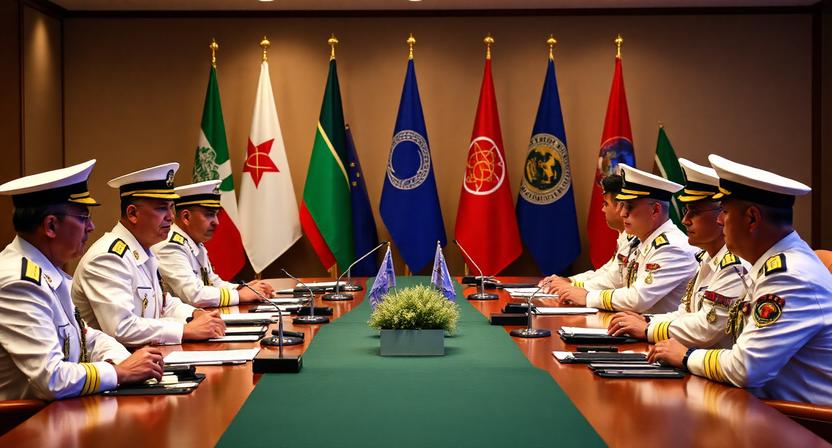The Global Naval Operations Updates provide an extensive overview of worldwide naval activities, reflecting current fleet deployments, multinational exercises, technological advancements, and strategic trends. Monitoring these updates offers insights into how modern navies maintain maritime dominance, ensure global trade security, and adapt to emerging threats.
Introduction
In 2025, naval operations are increasingly complex due to geopolitical tensions, technological evolution, and climate-driven challenges. The latest global naval operations updates highlight critical areas such as fleet deployments, modernization programs, joint exercises, humanitarian missions, and strategic partnerships. These updates help analysts, maritime enthusiasts, and policymakers stay informed about global maritime security developments.
Fleet Deployments Around the World
Indo-Pacific Operations
The Indo-Pacific remains a key strategic theater. U.S. and allied naval forces regularly conduct freedom-of-navigation patrols, joint exercises, and reconnaissance missions. These operations are aimed at preserving open sea lanes, deterring regional aggression, and supporting international trade routes. Deployments often include aircraft carriers, destroyers, amphibious assault ships, and submarines operating in coordinated task forces.
Mediterranean and Atlantic Missions
In European waters, NATO and allied navies are actively conducting anti-submarine warfare exercises, fleet coordination drills, and surveillance missions. These deployments enhance interoperability among European navies, improve readiness for potential conflicts, and ensure maritime security across vital shipping lanes.
Middle East Security Operations
Strategic waterways like the Red Sea, Persian Gulf, and Strait of Hormuz remain priority areas for naval operations. Escort missions for commercial vessels, counter-piracy patrols, and surveillance activities maintain stability in these high-risk regions while protecting international energy supplies.
Technological Advancements in Naval Operations
Autonomous and Unmanned Systems
Unmanned surface vessels (USVs) and autonomous underwater vehicles (AUVs) are increasingly used for reconnaissance, mine detection, and surveillance operations. These platforms reduce risk to personnel while enhancing operational efficiency, persistence, and precision in monitoring high-threat zones.
Fleet Modernization and Upgrades
Navies are modernizing warships with stealth capabilities, improved radar and sensor systems, and advanced precision weaponry. Amphibious assault ships, destroyers, and frigates are receiving technology upgrades to meet emerging maritime threats and multi-domain warfare requirements.
Artificial Intelligence Integration
AI is being deployed for predictive maintenance, threat assessment, mission planning, and operational decision support. This enables commanders to optimize fleet movements, anticipate adversary actions, and respond to rapidly evolving scenarios with greater accuracy and speed.
Joint Exercises and Multinational Collaboration
NATO Exercises
NATO-led exercises involve amphibious landings, anti-submarine drills, air-defense coordination, and electronic warfare operations. These activities enhance readiness, interoperability, and joint-response capabilities among allied nations.
Indo-Pacific Partnerships
Joint operations with Japan, Australia, and India focus on maritime surveillance, coordinated fleet maneuvers, and high-intensity simulated engagements. These exercises strengthen regional security and demonstrate collective deterrence.
Bilateral and Multilateral Drills
Other navies, including France, South Korea, and Singapore, engage in combined operations to enhance strategic cooperation, intelligence sharing, and operational effectiveness in high-traffic maritime zones.
Humanitarian and Climate-Oriented Missions
Modern navies are not limited to combat operations. They increasingly participate in humanitarian and climate-focused missions, such as:
- Coastal evacuations during natural disasters
- Search-and-rescue missions in remote or contested regions
- Environmental monitoring, particularly in Arctic and Antarctic regions
- Maritime infrastructure protection against climate risks
These activities showcase the dual-use capabilities of naval forces, blending security with humanitarian responsibility.
Cybersecurity and Operational Resilience
With greater technological integration comes heightened cyber risk. Navies are strengthening cybersecurity measures across communications, command centers, and autonomous systems. Continuous cyber training ensures that personnel can respond to attacks on operational networks, maintaining operational continuity and mission effectiveness.
Emerging Challenges in Global Naval Operations
- Geopolitical Tensions: The South China Sea, Arctic region, and Persian Gulf remain hotspots of strategic competition.
- Maritime Security Threats: Piracy, smuggling, and regional conflicts demand constant vigilance.
- Climate Adaptation: Rising sea levels, severe storms, and melting Arctic ice challenge naval readiness and require adaptive operations.
- Technological Complexity: Integration of AI, autonomous systems, and advanced platforms presents new maintenance, training, and cybersecurity demands.
Strategic Outlook
Global naval operations will continue to focus on enhancing autonomous and AI-enabled capabilities, expanding multinational cooperation, modernizing fleets, and addressing environmental and humanitarian missions. Monitoring these developments provides a comprehensive understanding of naval readiness, operational trends, and emerging global maritime threats.
Conclusion
The Global Naval Operations Updates offer a complete view of the dynamic maritime security environment in 2025. From fleet deployments and technological advancements to joint exercises and humanitarian initiatives, navies worldwide are evolving to meet both traditional and emerging challenges. Staying updated on these developments ensures strategic awareness and informed analysis of global naval operations.
FAQs – Global Naval Operations Updates
Q1. Which regions are most active in global naval operations?
The Indo-Pacific, Mediterranean, Atlantic, Middle East, and Arctic regions.
Q2. How are navies modernizing their fleets?
Through AI integration, autonomous vessels, stealth technology, and precision weapons systems.
Q3. Why are multinational exercises important?
They enhance interoperability, readiness, and strategic coordination among allied navies.
Q4. Are navies participating in humanitarian or climate operations?
Yes — missions include disaster relief, search-and-rescue, and environmental monitoring.
Q5. What emerging challenges do navies face?
Geopolitical tensions, cybersecurity threats, climate adaptation, and technological complexity are major challenges
 WhatsApp Us Now
WhatsApp Us Now









